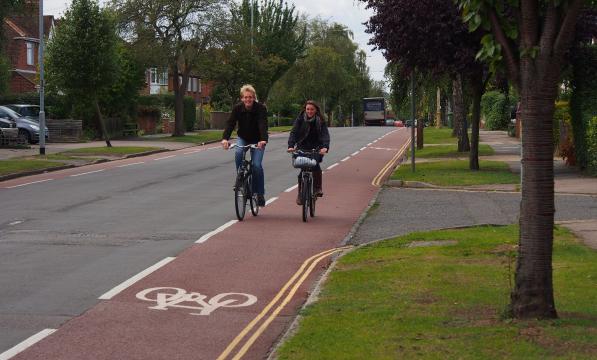Cycle lanes
By Cherry

Riding in an advisory cycle lane
Headline message
- Unseparated cycle lanes can help grow cycle use from a low base, but they are not a universal solution.
Important!
Please note: in July 2020, the Department for Transport published new guidance on cycle infrastructure design (LTN1/20). We will be revising all our advice, policy and materials on infrastructure in the light of it as soon as possible. This exercise will include reviewing this page.
Please also note existing cycle infrastructure design guidance for London, Wales and Scotland (revision due). Plus, technical guidance for Local Cycling and Walking Infrastructure Plans (LCWIPs, England).
Policy key facts
- Cycle lanes are painted on the carriageway, and the surface is often coloured red or green (the chosen colour has no significance).
- If the painted white line is solid, it means that the lane is ‘mandatory’ and drivers have to stay out of it during its time of operation, i.e. they can't park or drive in it. Cyclists, however, don’t have to stay within it.
- If the white line is dotted, it means that drivers are advised not to enter the lane, but it isn’t an offence if they do. To stop stationary cars blocking an advisory lane, it is common practice for councils to introduce parking, waiting and loading restrictions, so drivers must still observe the rules that any yellow lines impose on them.
- Research suggests that the presence of cycle lanes may encourage drivers to overtake cyclists more closely than they would if the lane wasn’t there.
Cycling UK view
- Unseparated cycle lanes can help grow cycle use from a low base, provided motor-traffic speeds and volumes are low enough and the lanes are sufficiently wide to take account of car doors being negligently opened in a cyclist's path.
- However, they are usually not good enough to make cycling safe and normal for everyone, so should be progressively upgraded to provide high quality protected space: the faster and busier the road, the greater the protection needed.
- Where cycle lanes are introduced, the absolute minimum width is 1.5 metres, but 2 metres is preferred and essential at higher speeds (exceptions to this may be necessary through protected cycle by-passes or to pass stationary traffic at junctions). Anything less than 1.5 metres (minimum) deprives cyclists of road space and encourages traffic to pass too close.
- Full width advisory lanes can be used on roads of any width, even the narrowest. Advisory cycle lanes should be thought of as indicators of the space cyclists need when they are being overtaken, not necessarily as exclusive space for cyclists.
- Car parking restrictions should be introduced and enforced to keep cycle lanes clear.
See our Space for Cycling guide for decision makers for more on the kind of infrastructure Cycling UK is calling on councils to introduce throughout the country.
2017-06-13 00:00:00 Europe/London



